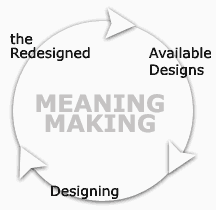2. WEB LITERACY THROUGH SOCIO-CONSTRUCTIVISM
2.2.1 AN APPROACH TO LITERACY AS A SOCIO-CONSTRUCTIVE PRACTICE: MULTILITERACIES
'Multiliteracies' is a term coined by the New London Group (2000) to
refer to the different literacies of today. The concept of Multiliteracies
is based on the notion of the challenges and demands literacy pedagogy
is facing in the different spheres of life today: the multiplicity of
communications channels and media, and cultural and linguistic diversity.
As an example, mass media and multimedia texts are often combinations
of textual, visual, audio and spatial elements, and how important these
elements are regarded, often depend on the cultural contexts they emerge
in. These elements are seen as different modes of meaning: linguistic
meaning, visual meaning, audio meaning, gestural meaning, spatial meaning
and the multimodal meaning, that is, the various combinations of the elements
above. In the pedagogy of Multiliteracies, these modes of meaning are
seen as dynamic resources that users constantly remake, and as part of
it, they learn to integrate many different modes of meaning-making. (Cope
and Kalantzis 2000:5-7). To describe this process of making meaning in
the various contexts, and as a metalanguage of Multiliteracies, the concept
of Design is introduced.
Design is a concept which refers to an idea that a person is both an inheritor
of patterns and conventions of meaning while at the same time an active
designer of meaning (Cope and Kalantzis 2000:5). Therefore, Multiliteracies
treats any semiotic activity, like reading or writing texts, as a matter
of Design. Design involves three elements: Available Designs, Designing,
and The Redesigned. To begin with, Available Designs are the available
resources for meaning, such as languages or other semiotic systems, and
conventions associated with them, such as discourses, styles, genres,
dialects and voices, as well as the way these relate to each other through
intertextual chains. The next element of the meaning-making process, Designing,
involves working with Available Designs and making new use of old materials.
Thus, activities such as reading, listening and seeing are seen more than
just a repetition of Available Designs: they always involve re-presentation
and recontextualisation of them. Designing, then, reproduces and transforms
given knowledge, social relations and identities in relation to the social
contexts in which they occur. In Designing, meaning-makers remake themselves
as well as produce new meanings and resources. The outcome, finally, is
The Redesigned. The Redesigned, therefore, are based on existing historically
and culturally received patterns of meaning, but at the same time, new,
transformed meaning, which, eventually, become new Available Designs.
(The New London Group 2000:19-23). Multiliteracies, then, can be seen
as an active and dynamic meaning-making process connected to existing
resources of meaning and defined by various socio-cultural aspects. The
idea of meaning making as designing is illustrated in Figure 1.

Figure 1. The process of meaning making (Adapted from The New London
Group 2000:19-23)
The tendencies discussed above are reflected in and through the web. On
the one hand, the web seems to be one of the new media causing changes
in working, public and private lives (see eg. Warschauer 1999:15, The
New London Group 2000:10-19). At work, the web functions as a new source
of information demanding new strategies of handling this information,
as well as brings along new ways of communicating. In public and personal
lives, the web functions more and more as a medium and also as a creator
of different communities, cultures and discourses.
The notion of cultural and linguistic diversity is unarguably relevant
on the web, since at least in principle, it is possible for many cultures
and languages to flourish on the open medium. In addition, the web is
a multimodal medium, where the importance of being able to integrate many
modes of meaning is emphasised. The process of Design on the web, therefore,
is based on many different kinds of resources for meaning making. The
web contains a number of multimodal text types, styles and genres, which
are organised in a hypertext form and combine many modes of representing
information. That is, meaning making on the web relies on both textual
and non-textual elements, as well as often on audio and spatial elements.
In addition, the web comprises a number of communities of web users from
various cultural and linguistic backgrounds. These elements function as
Available Designs for meaning making. Reading web pages, searching for
information, writing or publishing other material on the web, as well
as interaction, are instances of Designing on the web. The process of
Designing is affected not only by the discourses and the social and textual
norms of the web, but also by every users lifeworld experience and knowledge.
The learning space Netro is one way of applying the idea of Design to
web literacy. Netro is a learning space for web literacy, a space for
university students to learn about web literacy on the web. In other words,
Netro provides the learners a chance to become aware of the forms of reading
and writing connected to different web Designs. The vast variety of the
Available Designs on the web and the possibilities of reconstructing these
Designs collaboratively and openly offer the students learning possibilities
that make it possible to reflect and learn, and to become active participants
of the society itself. That is, Netro aims at supporting the development
of web related reading and writing practices that university students,
or any learners, may need when making use of this medium in their studies,
in work and in other areas of life. The way the pedagogy of Multiliteracies
and the idea of Design are applied in Netro is discussed in chapter
3.3.3.
In the following chapter, we will focus on the concept of web literacy
in more detail. We will define the aspects of literacy as a social practice
and the concept of Multiliteracies through one specific medium, the web.
Based on existing research on web literacy and related research areas
we will discuss the various dimensions of the concept of web literacy
as it understood in the present study.